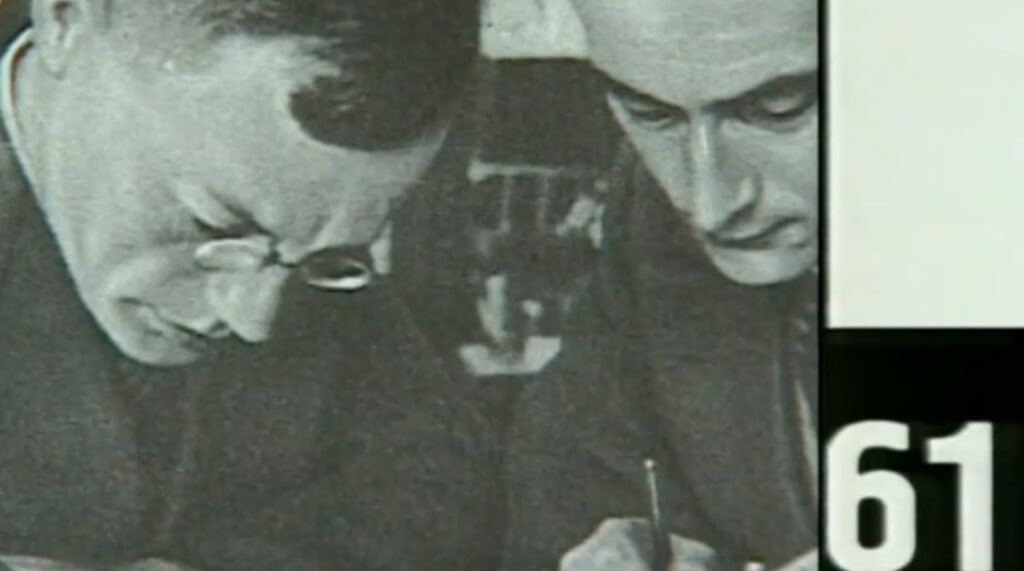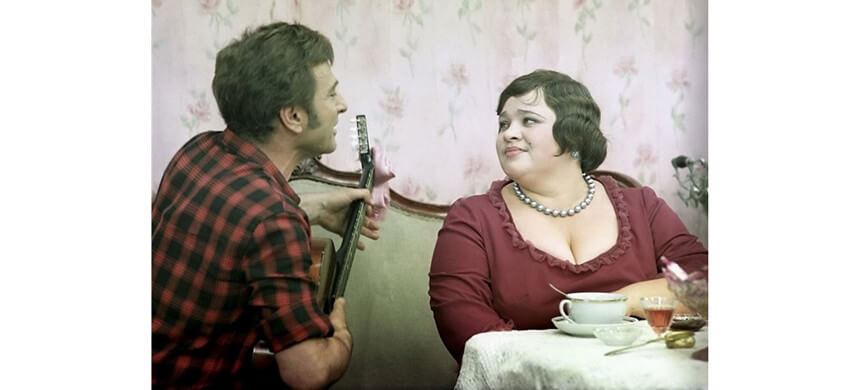Jew with the reputation of an adventurer: who was the prototype of Ostap Bender
He pretended to be a grandmaster for the sake of money, served in the criminal investigation department, spent years in camps due to financial fraud, and after being freed, he began to paint icons for the patriarch. Real life stories told to Ilf and Petrov immortalized the image of Osip Shor - it was he who became the prototype of the “great schemer” Ostap Bender.

Ilya Ilf and Yevgeny Petrov. Photo: frame video YouTube / The other day
Osip Benyaminovich Shor was born in the south-eastern part of Ukraine, in the city of Nikopol, tells Jewish.ru. The birth certificate of the boy was issued by Nikopol public rabbi 30 of May 1899 of the year. It states that the Bratslavsky 2 Guild of the merchant’s son, Benjamin Haimovich Shore, and his wife Kuni Gertsevna Berger, had a son Osip. In the family Shorov it was already the second child. The first, named Nathan, was born in 1897 year.
In 1901, Benjamin Shor died suddenly, and his wife and sons moved to Odessa. In this city, the youth of Osip, whose friends and acquaintances were called in the Ukrainian manner Ostap, passed. He studied at Shor in the same Iliad gymnasium, which was visited by “the great combinator” from Ilf and Petrov. After graduation, he entered the Physics and Mathematics Faculty of the University of Novorossiysk, but soon dropped out. He was more interested in other things: adventure literature, dreams of moving to Brazil - in connection with which Osip loved to dress in all white, gambling and football. Speaking of football. Sergey Utochkin, who founded two amateur football clubs in Odessa, considered the younger Shore a talented player and predicted his career as a great football player.
In 1916, Osip moved to Petrograd and entered the mechanical department of the Technological Institute. Soon the February revolution broke out, then the October revolution turned everything around. Famine began in the city, and Shor picked up a terrible bronchitis. It was not up to class. Bitterly regretting that he was in a damp and dank city on the Neva, he hurried south to his native Odessa. However, due to the reigning chaos in the country, the way home has been stretched for almost a year.
During this time, many adventures have happened to Osip. For example, in Kozmodemyansk, Osip Shore decided to earn extra money for local chess amateurs: posing as a grandmaster at a chess club, he collected some money from the players and conducted a simul. When in the "master" in the middle of the session they got to the core of the rogue, he had to urgently withdraw and flee from the angry mob on the boat. Ilf and Petrov in “The Twelve Chairs” turned Kozmodemyansk into Vasyuki, but the outline of the story told to him later by Shor himself was left almost unchanged.

Photo: jewish.ru/frame from the film “12 Chairs”
By the end of the summer, 1918, Shor finally got to Odessa. The city had experienced terrible devastation by then. Power changed every three to four months. The ball was ruled by raiders, gangster groups, criminals. “The Storm of Odessa” was known as Mishka Jap. It is Beni Creek's prototype in the works of Isaac Babel. With the criminal element actively fought. Osip's elder brother Nathan worked in the Odessa Criminal Investigation Department. True, by that time he was better known under the pseudonym of Anatoly Fioletov - the poet-futurist, the author of the Green Agatha, a much-talked-about poet in 1914, Writer Valentin Kataev in the book of memoirs “My Diamond Crown” indicates that the “Futurist brother” also began to work in the criminal wanted list and became known as “a brilliant operative worker.”
The bandits, with whom Osip now and then crossed the road, decided to remove him. However, the killers sent to the case took his brother Nathan for Shor - at least, Kataev says so. 21-year-old poet was killed right before his own wedding - he was going to marry a young poet Zinaida Shishova. Osip, as Kataev describes colorfully, found his brother's murderers: “Ostap spent the whole night in Havira visiting the bandits. They drank pure rectificate, recited the verses of the murdered poet, wept and with a gnashing of teeth they kissed passionately. ” Shore did not punish the gangsters, but after the incident with Nathan, he decided to end the criminalistics and left the criminal investigation department.
In 1922, Osip, who liked to introduce himself as the son of a Turkish citizen, moved to Moscow, where, through his old friends Yuri Olesha and Valentin Kataev, he met the employees of the Gudok newspaper - Ilya Ilf and Kataev’s younger brother Evgeniy Petrov. He became a member of the circle of Odessa writers who were now living in the capital, and gladly shared with them the stories of his adventures, full of curiosities and adventures. Ostap told, for example, how during his long journey from Petrograd to Odessa, in order to earn money, he posed as either a fire inspector or an artist.
As Kataev writes, “ironic, immense, broad-shouldered,” Shore, always ready for a sharp joke, conveyed to the great combineor not only some of his stories, but also features. Even the appearance of Osip Ilf and Petrov "retained in his novel almost completely intact: athletic build and romantic, purely Black Sea character."
The idea to write a novel about the pursuit of diamonds hidden in 12 chairs belongs to Kataev. He presented his idea to Ilf and Petrov. True, if Kataev's main character was Vorobyaninov, then the co-authors came to the first place Bender. The book was written in the 1927 year, and published the following year. Amazingly, it is about this time of Osip Shore’s life that is least known. He seemed to give way to his prototype.
In the 1931 year, in the year when the Golden Calf was published, Shor moved from Moscow to Chelyabinsk, where he settled for a supply to the Chelyabinsk Tractor Plant under construction at that time. He worked there for a little over a year. His personal record has not been preserved, but it is known that it counted 29 pages - much more than the work of any other employee. Most likely, these pages contain the mysterious circumstances of the dismissal of Osip. It is only known that for some financial frauds against Shor opened a criminal case. As punishment, the former criminal investigation inspector received five years in the camps.
There is no exact information about what happened to Shore after being released from the camp. Again, his figure appears in the memoirs and documents during World War II. Shor's great-niece Natalya Kamyshnikova-Pervukhina writes that in 1941, he received a referral to Central Asia — he was to be accompanied by an evacuated Moscow zoo. According to her, immediately after the end of the war, Ostap mastered the art of silk-screen printing and for several years produced icons for the Trinity-Sergius Lavra with this method. This case, though threatened with the danger of a new prison term, brought a good income. However, when Patriarch Alexy I was informed that the icon painter was a Jew with the reputation of an adventurer, this “market” was closed for Ostap.

Photo: jewish.ru/frame from the film “12 Chairs”
Some scenes from the life of Ostap Bender, invented by Ilf and Petrov, were embodied in the fate of Osip Shor. For example, at the end of 1950, an aged adventurer married a woman who was painfully similar to Madame Gritsatsuyeva. “A languid ... decorated with jewelry and thick cosmetics, an extremely plump person of about thirty-five with dark oriental red eyes,” said Shore's wife Kamyshnikova-Pervukhin. True, unlike comrade Bender, Shore did not run away from his wife, but lived with her 10 for years. Then the couple left. Osip, whose character in old age, according to the memories of households, became simply unbearable, remained to live out his life in an uncomfortable room communal in one of the new neighborhoods of the capital.
Perhaps the reason for traveling with his wife was the fact that Shor constantly brought former convicts into the house - he fed them, gave them an overnight stay. According to a friend and pupil of Osip Shor, an artist and a silk screen recorder Viktor Yoels, a former prisoner helped the families of prisoners for years, saved often unfamiliar people from harm. “There were not many houses in Moscow where you could come to spend the night after returning from the camp. Almost strangers came, stayed, sometimes lived for a long time, while he did not arrange them to work, did not find them any opportunity to stay in the city, ”Joel told about his teacher.
Ostap Shor died in the 1978 year, and then the mysterious novel by Valentin Kataev “My Diamond Crown” came out. Thanks to this book, the story of Ostap Shor as a prototype of Bender became canonical. Kataev wrote: “Ostap was drawn to the poets, although in his entire life he had not written a single line of verse. But in his heart, of course, he was a poet, the most peculiar of us all. That was the prototype of Ostap Bender. ”
Read also on ForumDaily:
The story of David Leibovich, inventor of Israeli artillery from Russia
'Nenashi' in the USA: how immigrants from different countries survive in New York
10 facts that we learned from Parfenov’s second film about Russian Jews
Subscribe to ForumDaily on Google NewsDo you want more important and interesting news about life in the USA and immigration to America? — support us donate! Also subscribe to our page Facebook. Select the “Priority in display” option and read us first. Also, don't forget to subscribe to our РєР ° РЅР ° Р »РІ Telegram and Instagram- there is a lot of interesting things there. And join thousands of readers ForumDaily New York — there you will find a lot of interesting and positive information about life in the metropolis.











